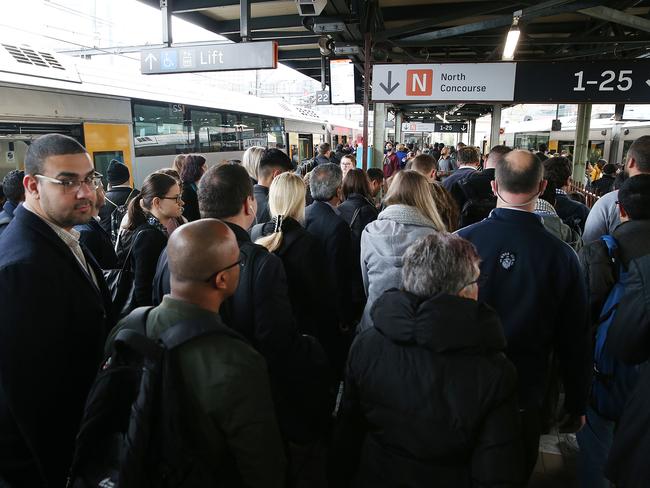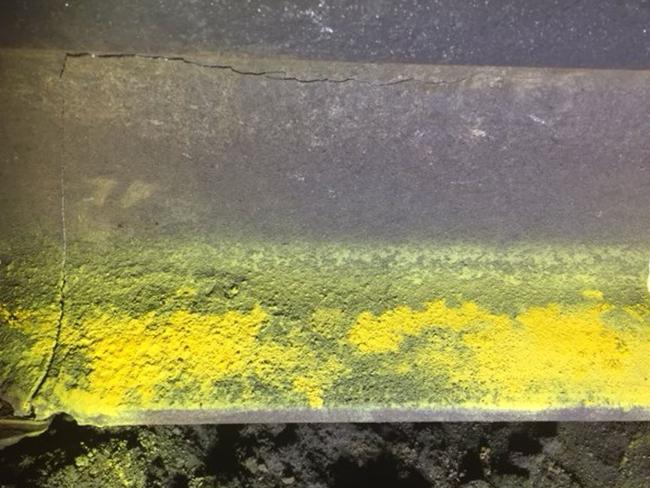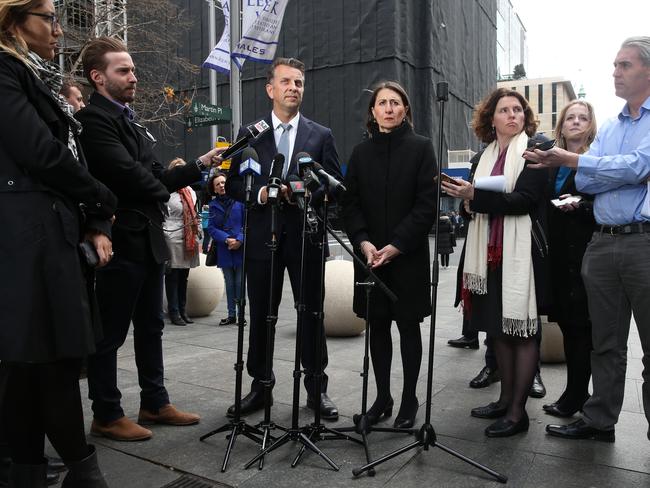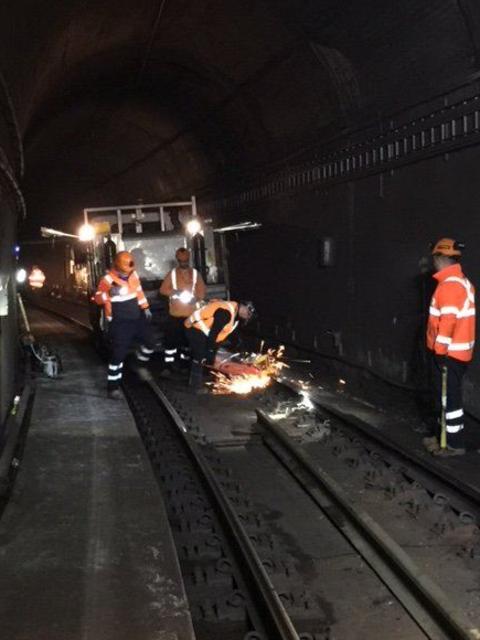Ageing tracks cause ongoing chaos for Sydney rail commuters
A TINY crack in a railway line near Town Hall was enough to plunge Sydney’s train network into chaos today, with delays expected to last well into this afternoon. Transport Minster Andrew Constance said Sydney could have faced a major derailment if the crack had not been detected.
NSW
Don't miss out on the headlines from NSW. Followed categories will be added to My News.
A TINY crack in a railway line near Town Hall that could have been caused due to ageing tracks or cold weather was enough to plunge Sydney’s train network into chaos today, with delays expected to last well into this afternoon.

Sydney Trains chief executive Howard Collins told reporters one metre and a half of rail — weighing more than one tonne — had to be replaced by crews after a special “testing train” uncovered the damage.
Cracks in railway lines, which often cannot be seen by the naked eye, can cause rails to break and lead to trains derailing.
When asked what caused today’s crack, Mr Collins said the cracked railway line was more than 20 years old.
“It’s a 1996 rail … you think about 400 tonnes going around there every three or four minutes,” he said.
“Cracked rails are quite rare, this one is very rare.

“We’re doing more testing and therefore we found this before it caused a major issue.
“I think people have got to understand we’re using this rail intensively. We’re doing open-heart surgery while running a marathon here. We’re upgrading a network and sometimes things don’t go according to plan.”
Mr Collins said the amount of commuters using Sydney’s rail network had increased by 30 per cent in the past five years, placing increased pressure on services.
Changes in temperature can also cause metals in railing to expand.

“Cracks in the steel rail occur for a variety of reasons … we thoroughly investigate the causes of each incident,” a spokesman for Sydney Trains said.
“Early detection allows for appropriate maintenance interventions to prevent a potential incident.”
The repair works centred on an underground stretch of rail in between Town Hall and Wynard stations.
Trains in the City Circle could only run in one direction during the peak of the morning commute.
Sydney Trains said delays could still hit the Airport, Inner West, Leppington and Bankstown lines throughout the day following the repair works.
“Please continue to allow additional travel time due to a cracked rail at Town Hall earlier,” the authority said just before noon.
“Regular services are operating but some delays are expected. Please listen to announcements (and) check indicator boards prior to boarding your service.”
Last time there was a cracked rail on the #sydneytrains network was back in January and the entire system came crashing down.
— Thomasee (@thomasee) August 26, 2018
One relieving factor then was that it was school holidays. No such luck today.
Brace yourselves ... pic.twitter.com/tG0k6cYPhb
Waiting for the day that Sydney trains can get it right... @T8SydneyTrains pic.twitter.com/8mFj5Jt39X
— Jeffrey Chan (@tweetswithjeff) August 26, 2018
The incident has sparked fierce criticism over the reliability of Sydney’s train network.
“Just a quick shout out to #sydneytrains for making my 20 min trip into 90 today. Was supposed to be half an hour early ended up being half an hour late. Good work,” one commuter tweeted.
SYDNEY COULD HAVE HAD A MAJOR DERAILMENT
SYDNEY could have faced a major derailment in a tunnel with a “fully laden train” in morning peak if a cracked rail gauge had not been detected, NSW Transport Minster Andrew Constance said today.
Apologising for the morning delays, Mr Constance said a sonar sweep at 3am detected a “major crack” in underground rail lines between Town Hall and Wynyard and authorities had no choice but to “put safety first” and divert trains.
Thousands of commuters were affected by snowballing delays across Sydney this morning as rail crews replaced 1.5 tonnes of steel track in the tunnel. The government has promised services are back to normal for the evening peak.

Premier Gladys Berejiklian also apologised for the disruption, coming on top of delays on the weekend as well as last week, with Opposition Leader Luke Foley calling for Mr Constance’s scalp.
“If we hadn’t picked it up, it could have had tragic consequences,” Ms Berejiklian said.
“There’s no excuse for when situations like this morning and the previous weekend occurred. They let people down and I don’t like to see that.
“Would I prefer they are not picked up in peak hour — of course,’ she said. “But the important thing is the network … is going to deliver peak in evening.” She said the government was pouring “billions” into the existing heavy rail network to avoid such incidents, not just building new lines.
“I want the travelling public to know we are moving heaven and earth to prevent these incidents from occurring,” she said.

Mr Constance said authorities still managed to get half a million commuters into the city, despite cancellations and delays on the City Circle line and knock-on delays hitting other lines, including the T2 Inner west and Leppington Line, T3 Bankstown, T8 Airport and South line. He said a sick passenger at Redfern had also contributed to the meltdown. The city circle was back in operation after 8.20am.
“If they hadn’t have done that (detect the crack) we could have faced a major derailment in a tunnel during the morning peak with a fully laden train,” Mr Constance said.
“I know what I’d prefer. I apologise for the inconvenience caused but I’m not going to apologise for us investing in safety like we have. There’s twice the number of inspections under Howard Collins’ (railway chief executive) regime now than when he came in.”
Mr Constance rejected Opposition suggestions the delays were caused by the new timetable introduced last year, saying the incidents that had caused the weekend delays were unrelated.
He said the government was working hard for the past five years to “detangle” the “old” network system so incidents are isolated.

Five years ago there was 306 million passenger trips on railway network, today over 400 million,” he said.
“It’s increased by 30 per cent in five years. We had no option but to put more trains on tracks and change the timetables.”
The NSW Premier also today announced a milestone in building Australia’s first new metro railway, running from the city to the North West and will open next year, with testing now underway.
The metro trains will be driverless, automated trains with screen glass doors and operate on a “turn up and go” system.
Ms Berejiklian said the first train has entered the Sydney Metro tunnels and three new underground metro railway stations have now been “topped off”, with work rising from ground level from 25 metres underground.
On-board systems were tested as well as signalling, braking and acceleration at different speeds in the tunnel with testing progressively increasing up to 100km/h.
Mr Andrew Constance said over the coming months it will be tested beyond Norwest through the full length of the new tunnels.”
More than 10,000km of train testing has taken place so far on the Sydney Metro system, with 12 of the fleet of 22 trains delivered.

“This incredible train with three doors on its side is going to move around 46,000 passengers per hour compared to the existing network of around 20000,” Mr Constance said.
“It will take enormous pressure off the public transport woes the people of the northwest have experienced for generations.”
Sydney Metro opens in the city’s north west in the second quarter of next year with 13 metro stations, 4000 commuter car parking spaces and 36km of new metro rail.
